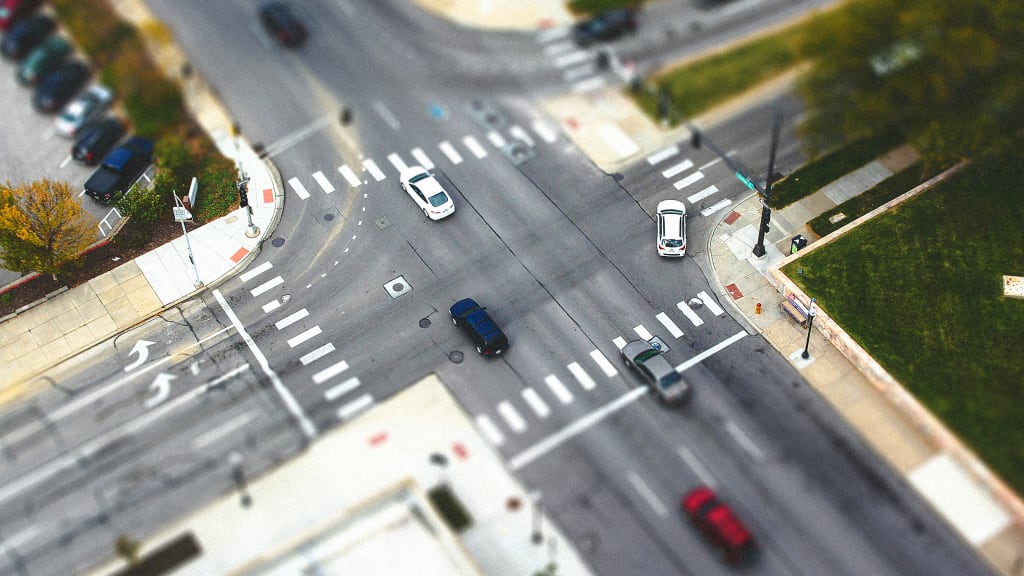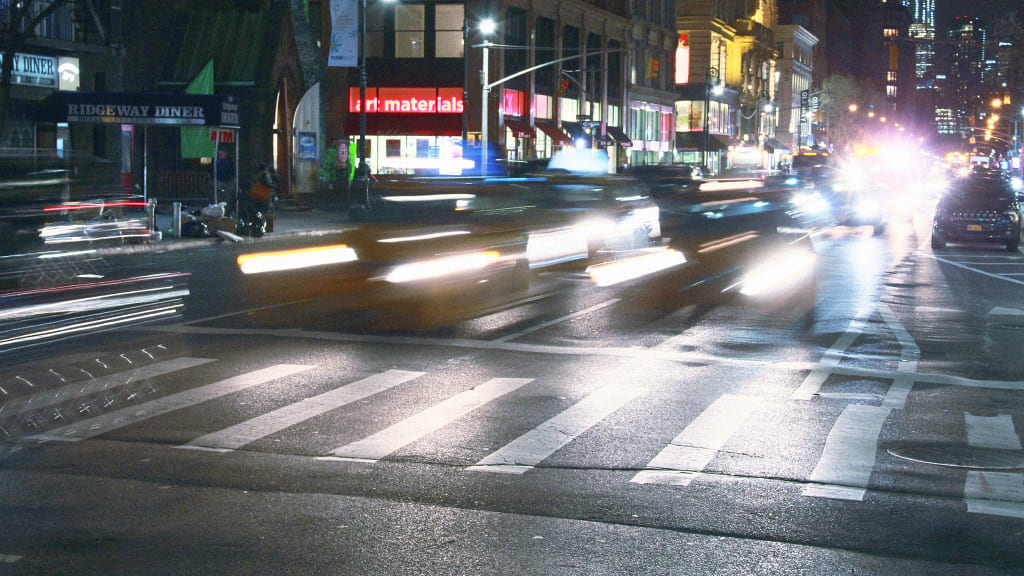U.S. crash deaths are much more common than in other rich countries, leading many public leaders to proclaim that “Road safety is a shared responsibility.”
Safety nonprofits say it. Michigan Governor Gretchen Whitmer says it. Transportation Secretary Pete Buttigieg says it. The message is community-spirited if anodyne: The quest for safer roads requires everyone to contribute, whether they be transportation professionals or commuters simply trying to get to the office.
Innocuous though it may seem, the refrain encapsulates much of what’s wrong with road safety in the U.S., where crash death rates are at least double other rich countries, from Japan to Finland to Canada.
In reality, the duty to prevent collisions should fall on the road engineers, car companies, and public officials who create the system in which people drive, bike, or walk—and not on road users themselves. By lumping everyone together, the phrase blurs that distinction, allowing those who can do the most to save lives to dodge accountability.
Subscribe to the Compass newsletter.Fast Company's trending stories delivered to you daily
The idea of a shared responsibility for road safety comes from the Safe Systems approach, a framework that has gained adherents in recent decades. As the Department of Transportation’s website explains, collective involvement is central to Shared Systems: “All stakeholders—including government at all levels, industry, nonprofit/advocacy, researchers, and the general public—are vital to preventing fatalities and serious injuries on our roadways.”
The problem is that some of those groups have far more leverage over road safety outcomes than someone driving or walking down a street. Highway engineers, for instance, can design a roadway with sidewalks and bike lanes, or they can force pedestrians and bicyclists to share a lane with motor vehicles whizzing by. Automakers can produce modest-size vehicles that prevent reckless speeding, or they can sell hulking SUVs and pickups that exceed the highest U.S. speed limit by more than 50 mph. State legislators, for their part, can fully fund transit systems whose passengers are orders of magnitude safer than those in a car, or they can choose not to.

“If we were going to ‘share responsibility’ among those who have power over the system itself—auto companies and road designers and so on—I’d say fine,” says Seth LaJeunesse, a senior research associate at the University of North Carolina’s Highway Safety Research Center. “But why are we including the public? They’re just using the system. They’re not actually changing it.”
To his point, a traveler can choose to wear a seat belt or bike helmet, but individual actions can only go so far. There isn’t much that a pedestrian can do to protect herself if walking home from the bus stop requires traversing a six-lane arterial where cars whiz by at 50 mph. And nothing can protect occupants of a sedan struck by a legally lifted monster truck. Individual road users who violate reasonable road rules should be punished, but sporadic enforcement undercuts those rules’ ability to deter reckless behavior. That failure underscores flawed policies (like banning automatic traffic cameras) and underperforming criminal justice systems, which elected officials can fix.
Ignoring the underlying causes of crashes and instead laying blame on individual road users is an ingrained and counterproductive American habit supported by powerful groups eager to escape the spotlight. Car companies, for instance, make disproportionate profits from oversized SUVs and pickups that researchers have linked to pedestrian deaths, which in 2022 hit a 40-year high in the U.S. Many highway engineers trained to prioritize traffic flow prefer to continue ignoring the inevitable tension between speed and safety.
Such stakeholders are happy to emphasize individuals’ role in crash reduction, which helps to explain the enduring popularity of highway messaging boards sharing public service announcements like “buckle up, windshields hurt,” despite a dearth of evidence suggesting that they do anything to enhance road safety. Since some people will inevitably choose not to wear a seat belt, a better safety approach would adjust road and vehicle designs to mitigate the damage when collisions do happen.
That idea of harm reduction is central to Vision Zero, the road safety strategy that has been wildly successful in northern European cities like Warsaw, where crash fatalities recently reached an all-time low. Rather than attempt to change human behavior, Vision Zero revolves around the idea that people will inevitably make mistakes, which should not be fatal. Prioritized policies include lower speed limits and narrower lanes that can prevent catastrophic outcomes when something goes wrong on the road.

“The idea is that if there are too many crashes, too many injuries, and too many deaths, the system designers go back and redesign the system,” said Anine Hartmann, an urban planner who works on road safety in Oslo, which recently went a full year without a single pedestrian or cyclist fatality. People walking, biking, and driving should be treated separately from transportation professionals, Hartmann said, since they are simply consumers of that system.
Policymakers who accept road users’ fallibility will naturally gravitate toward certain safety tactics and away from others (e.g., guardrails are more effective than a “curve ahead” sign). In contrast, “Safety is a shared responsibility” is an exhortation rather than a strategy. Even if government officials concur, how does it help them choose among various tactics?
In fact, LaJeunesse thinks the phrase’s vagueness explains much of its appeal among safety professionals, many of whom see it as reinforcing the status quo. “It leads people to believe that what they’ve been doing all along is just fine, and that there is no reason to change,” he told me. To his point, transportation executives have invoked the “shared responsibility” line as a shield, deflecting criticism by pointing to the need for others to act, too.
By attempting to hold everyone accountable for safety outcomes, the shared responsibility framework effectively holds no one accountable. The psychologist Albert Bandura described how diffusion of responsibility makes people less likely to act when they believe others could do so instead. Laying the blame for America’s uniquely dangerous roads on individuals undercuts the urgency that transportation engineers, car companies, and policymakers should feel to change course.
For another recent example of the same pernicious tendency, consider the false idea that human error causes 94% of crash deaths. In a 2015 fact sheet, the National Highway Traffic Safety Administration stated that in 94% of crashes, human error was “the last failure in the causal chain of events leading up to the crash.” This makes sense, as crashes usually have many contributing factors (a dangerous intersection, a distracting infotainment system, and so on). Although NHTSA specified that the road user’s role is “not intended to be interpreted as the cause of a crash,” a slew of autonomous vehicle executives and state transportation officials chose to ignore that guidance.
Like the “shared responsibility” refrain, the 94% misinterpretation allows those with real power over road safety to elude accountability. As National Transportation Safety Board Chair Jennifer Homendy pointed out, it “relieves everybody else of responsibility they have for improving safety.” Under pressure, in 2022, the Department of Transportation removed a prominent reference to the figure from its website.
American roads became a little bit safer when USDOT acknowledged that the 94% line was not an accurate or constructive road safety framework. It should do the same with the notion that crash reduction is a shared responsibility. Sure, everyone can do something to make collisions less likely. But some can—and should—do far more than others.
The application deadline for Fast Company’s World Changing Ideas Awards is Friday, December 6, at 11:59 p.m. PT. Apply today.